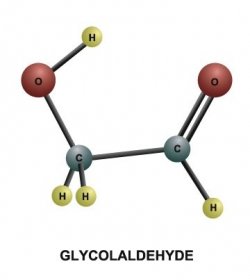strollingbones
Diamond Member
A sugar molecule linked to the origin of life was discovered in a potentially habitable region of our galaxy.
The molecule, called glycolaldehyde, was spotted in a large star-forming area of space around 26,000 light-years from Earth in the less-chaotic outer regions of the Milky Way. This suggests the sugar could be common across the universe, which is good news for extraterrestrial-life seekers.
"This is an important discovery as it is the first time glycolaldehyde, a basic sugar, has been detected towards a star-forming region where planets that could potentially harbor life may exist," Serena Viti of University College London said in a press release.
Previously, glycolaldehyde had only been observed toward the center of the galaxy, where conditions are thought to be too extreme to host habitable planets.
Glycolaldehyde is a key ingredient for life. It helps to build Ribonucleic acid (RNA), which is thought to be the central molecule involved in the origin of life on Earth. Glycolaldehyde is a monosaccharide sugar, the basic unit of carbohydrates. It can react with the chemical propenal to form ribose, the building block of RNA.
"The discovery of an organic sugar molecule in a star forming region of space is very exciting and will provide incredibly useful information in our search for alien life,” said Keith Mason, chief executive of the England’s Science and Technology Facilities Council.
The finding, made with the IRAM radio telescope in France, was announced Tuesday and will be published in the Astrophysical Journal Letters.
The molecule, called glycolaldehyde, was spotted in a large star-forming area of space around 26,000 light-years from Earth in the less-chaotic outer regions of the Milky Way. This suggests the sugar could be common across the universe, which is good news for extraterrestrial-life seekers.
"This is an important discovery as it is the first time glycolaldehyde, a basic sugar, has been detected towards a star-forming region where planets that could potentially harbor life may exist," Serena Viti of University College London said in a press release.
Previously, glycolaldehyde had only been observed toward the center of the galaxy, where conditions are thought to be too extreme to host habitable planets.
Glycolaldehyde is a key ingredient for life. It helps to build Ribonucleic acid (RNA), which is thought to be the central molecule involved in the origin of life on Earth. Glycolaldehyde is a monosaccharide sugar, the basic unit of carbohydrates. It can react with the chemical propenal to form ribose, the building block of RNA.
"The discovery of an organic sugar molecule in a star forming region of space is very exciting and will provide incredibly useful information in our search for alien life,” said Keith Mason, chief executive of the England’s Science and Technology Facilities Council.
The finding, made with the IRAM radio telescope in France, was announced Tuesday and will be published in the Astrophysical Journal Letters.
Attachments
Last edited:


